Last Updated on January 20, 2024 by Greg Gillson
Did you see a brightly colored red bird, orange bird, or yellow bird in Montana and wonder what it was?
This page is for you!
This article shows you photos and identification of some of the most common birds in Montana based on color.
The list of birds found in Montana includes over 430 species. So, I can’t show you all of them. I’m going to assume that you saw a common bird of this color, but you certainly could have seen something less common, or even rare!
Shape (including the shape of the bill) and size are often more helpful in starting to identify a bird than the color. In fact, most birds in North American can be easily identified with a black-and-white photo!
Many birds are multi-colored, so that it may be hard to pick out a dominant color. Males and females may be colored quite differently. And some color patterns are similar among otherwise dissimilar species.
Nevertheless, I’m going to try to pick out some of the birds that you are most likely to see in backyards or towns. And I’ll show a few others that I get asked about a lot.
The birds with a noticeable amount of red on them in Montana covered in this article are:
- American Robin
- House Finch
- Red Crossbill
- Cassin’s Finch
- Common Redpoll
The birds with a noticeable amount of orange on them in Montana covered in this article are:
- Northern Flicker
- Red-breasted Nuthatch
- Barn Swallow
- American Kestrel
- Ruddy Duck
- Cinnamon Teal
- Spotted Towhee
- Black-headed Grosbeak
- Bullock’s Oriole
- American Redstart
The birds with a noticeable amount of yellow on them, including lots of yellow and black birds, in Montana covered in this article are:
- Western Meadowlark
- Pine Siskin
- American Goldfinch
- Yellow Warbler
- Yellow-rumped Warbler
- Cedar Waxwing
- Evening Grosbeak
- Western Tanager
- Yellow-headed Blackbird
- Common Yellowthroat
- Western Kingbird
- MacGillivray’s Warbler
Red birds of Montana
Birds get the red, orange, and yellow in their feathers from carotenoids in the fruit, seeds, and plants they eat (source).
These carotenoid colors combine with melanin to form an infinite range of red feathers–pink, rusty, scarlet, violet, red-orange.
The following are red birds that you are most likely to see in Montana.
American Robin
These are familiar lawn birds with red breasts.
 |
| American Robin. Greg Gillson. |
Male American Robins are brownish-gray above with a brick red breast. Females are paler orange below and paler gray above.
They are widespread in open country with scattered deciduous trees, residential areas.
American Robins are year-round residents throughout most of Montana, summer residents only in northeastern Montana.
House Finch
When people ask about a bird with a red head at their feeder, it is usually this bird.
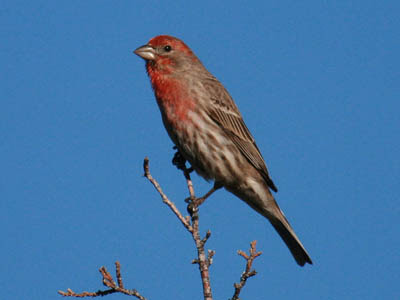 |
| Male House Finch. Greg Gillson. |
Males of this dusty brown striped finch have red limited to the head (specifically the forehead and eyebrow), breast (chest), and rump. The red coloration tends toward orangish and may rarely be yellowish.
Females are streaked, similar to the males but without red. They lack any strong pattern on the face and head.
Note the small round head and curved upper ridge on the bill.
Some people call these red-headed sparrows. Sparrows and finches are similar, but in general, male finches are brighter than the females and tend to hang out more in trees. Sparrow genders are usually quite similar in coloration and tend to feed mostly on the ground.
These birds are common in residential areas, especially at bird feeders. In the West more widespread in arid regions near water.
House Finches are year-round residents in southeastern and central Montana.
Red Crossbill
These red finches use their uniquely crossed bills to pry seeds from cones.
 |
| Red Crossbill. Greg Gillson. |
Males are deep red with blackish wings and forked tail.
Females more yellowish-green.
Always found in conifers, frequently in the mountains. Much variation in bill size. Smaller-billed populations feed on small spruce and fir cones. Larger-billed populations feed on large hard pinecones.
Red Crossbills are year-round residents throughout most of Montana, winter visitors only in northeastern Montana.
Cassin’s Finch
These red finches are found in ponderosa pine.
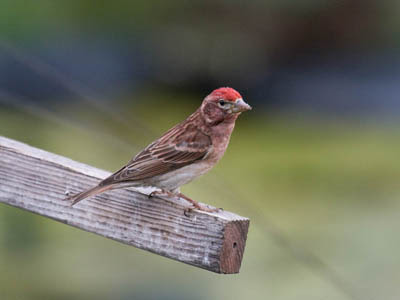 |
| Cassin’s Finch. Greg Gillson. |
Males of these brownish finches are frosted with pink on the upper parts. The crown is the brightest red. They are not streaked on the under parts.
Females lack the red. They have a pale outline of the darker ear patch. Like the males, females are shaped with a large bill that is straight on the upper ridge. The tail is strongly forked.
These finches are found in dry mountain forests of ponderosa pine and juniper. Similar Purple Finches are found in deciduous and wet conifers. House Finches are found in towns everywhere.
Cassin’s Finches will visit feeders within pine forests.
Cassin’s Finches are year-round residents in western Montana, absent in eastern Montana.
Common Redpoll
These frosty pink and red birds are northern relatives of the goldfinches.
 |
| Common Redpoll. Greg Gillson. |
These birds are frosty white in winter with brown striping above and on the sides. Both genders have red caps, black around bill and chin. Adult males have red upper breast. Immatures less red.
These birds are found in weedy fields and alder and birch trees in winter. Come to thistle feeders.
Common Redpolls are regular winter visitors in northwestern Montana, rare winter visitors throughout the state.
Orange birds of Montana
True orange-colored birds are not that common. Many birds that I have here are paler rusty.
The common pattern is an orange body and black or brown wings and tail. Another common pattern is for the orange to be restricted to the under parts.
The following are orange birds that you are most likely to see in Montana.
Northern Flicker
These unusual woodpeckers with orange under wings are just as likely to be found hopping on your lawn eating ants as they are to be calling from a dead treetop.
 |
| Northern Flicker. Greg Gillson. |
Where is the orange color?
Wait for it…
 |
| Northern Flicker. Greg Gillson. |
The shafts and undersides of the wing and tail feathers are a salmon orange color. A large white rump patch also attracts attention as these birds fly away.
Northern Flickers live in open woods, residential areas. Sometimes visit feeders in winter.
Northern Flickers are year-round residents throughout Montana.
Red-breasted Nuthatch
These active little red-breasted birds crawls all around on the trunk and big branches of conifers. They search crevices in the bark for insect food.
 |
| Red-breasted Nuthatch. Greg Gillson. |
These tiny birds have blue-gray backs and a black line through a white face. Some males can have quite bright rusty red under parts. Some females can have quite pale buff-colored under parts. Most birds show an orange-cinnamon breast color.
Found nearly exclusively in conifers. Readily come to feeders.
Red-breasted Nuthatches are year-round residents in western Montana, winter visitors throughout the state.
Barn Swallow
These orange-bellied birds are a familiar sight across North America in summer.
 |
| Barn Swallow. Greg Gillson. |
These birds are purple-blue above with orange under parts and long forked tails. The color of the underparts in winter or on females are often cinnamon or buff-colored, but breeding males can be brighter orange-red.
These birds swoop low over fields and wetlands at lower elevations. They may build their mud nests in rafters on porches, garages, or other out-buildings.
Barn Swallows are summer residents throughout Montana.
American Kestrel
These are the familiar small rusty-orange falcons sitting on power lines on the edge of the highway or hunting and hovering over the median strip.
 |
| Female American Kestrel. Greg Gillson. |
Females are rusty orange barred with black on their back wings and tail. The under parts are buff with black spots. The head shows two facial stripes.
Males have blue-gray backs and rufous tail is unmarked except for black tail band.
These birds are found in open country, farms, pastures with perches.
American Kestrels are summer residents throughout Montana.
Ruddy Duck
These small ducks are dark rusty-orange in spring.
 |
| Ruddy Duck. Greg Gillson. |
Males in breeding plumage (late winter and spring) are rusty, with a white face, and a blue bill. The long tail is often held sticking up. In winter they are brown, with white face, and dark bill.
Females all year are like winter males. Brown body, dark cap, dark line through eye of pale face. Dark bill.
These birds prefer weedy ponds to breed, but in winter may be found in deeper ponds in city parks.
Ruddy Ducks are summer residents throughout Montana.
Cinnamon Teal
What an unusually colored brownish-orange duck!
 |
| Male Cinnamon Teal. Greg Gillson. |
Males are dark cinnamon orange. The wing patches are blue, green, and white. The eye is red.
Females are more mottled brown with matching wing patches.
These birds are found in ponds and grass-lined ditches.
Cinnamon Teals are summer residents throughout Montana.
Spotted Towhee
These big sparrows with red sides superficially resemble the coloration of robins.
 |
| Spotted Towhee. Greg Gillson. |
These birds have dark hoods and upper parts with rusty rufous-red sides and white bellies. They have white spots over their wings, shoulders, and on their tail corners. The upper parts of the males are jet black, females dark brown. Some populations have paler orange sides.
These are somewhat shy birds that hide in the dense brush and spend most of their time on the ground. They visit feeders during quiet periods.
Spotted Towhees are summer residents throughout Montana.
Black-headed Grosbeak
If you didn’t look closely at these big-billed birds, you might mistake these orange-breasted songsters for American Robins–their coloration and song are very similar!
 |
| Male Black-headed Grosbeak. Greg Gillson. |
Males have black and white wings and tail. Huge bill. The under parts are burnt orange, fading to yellow-orange mid-belly.
Females and first year birds have a striped heads and are brown above, pale buff or butterscotch-orange below.
These birds are found in deciduous or mixed woods. Visit bird feeders.
Black-headed Grosbeaks are summer residents throughout Montana.
Bullock’s Oriole
These bright orange and black birds are often seen in tall trees.
 |
| Male Bullock’s Oriole. Greg Gillson. |
The males of this species are very bright orange. The back and top of the heads are black. The black wings have large white wing patches. The tail is black with orange sides. The face is orange with a black line through the eye and a black throat.
Females and young are gray with yellow head and breast and tail.
These birds are more common in drier inland regions along watercourses in tall cottonwoods or shade trees. Rarely come to feeders for fruit or nectar in spring.
Bullock’s Orioles are summer residents throughout Montana,
American Redstart
In flight these small warblers flash orange or yellow in the wing and base of the tail.
 |
| American Redstart. Dennis Jarvis. Flikr. CC BY-SA 2.0 |
Males are black above, white on the belly. They have bright orange patches on side of breast, wings, and base of the tail.
Females are grayer, especially on the head. The orange of males is replaced by yellow on the females.
These birds are found in regenerating woods after a clear cut, and willow tangles along streams.
American Redstarts are summer residents in western and far eastern Montana, absent in east-central Montana.
Yellow birds of Montana
Yellow is a common bird color! Often it is mixed with black and white plumage in birds.
Many birds with darker upper parts have yellow breast or belly.
The following are yellow birds you are most likely to see in Montana.
Western Meadowlark
These are streaky camouflaged prairie birds from above or from behind. But from the front, the breast is shocking yellow!
 |
| Western Meadowlark. Greg Gillson. |
They are streaked brown, black, and gray on the upper parts. The underparts are golden yellow with a black necklace crossing the upper breast. Much paler yellow in fall and winter, as the yellow feathers are tipped with white and streaked with brown.
These are birds of pastures and grasslands and arid regions.
Western Meadowlarks are summer residents throughout Montana.
Pine Siskin
These small brown-streaked birds are relatives of the goldfinches. But you would never know it until they fly and sport yellow wing stripes and tail base. Usually in flocks.
 |
| Pine Siskin. Greg Gillson. |
These birds are streaked brown. In flight they have a yellow stripe down the length of the wing. The sides of the base of the tail are also yellow. Some birds are paler, some darker, others brighter yellow, others duller.
These birds are found in summer in northern conifer woods. Irregularly irrupt hundreds of miles southward. Frequent at feeders.
Pine Siskins are year-round residents in central and western Montana, winter visitors only in eastern and northern Montana.
American Goldfinch
These small little birds are bright yellow and black.
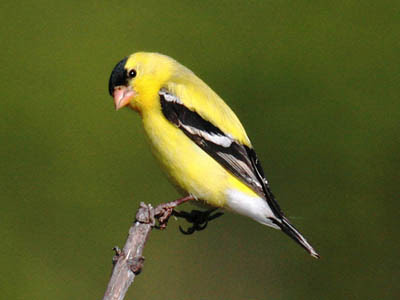 |
| American Goldfinch. Greg Gillson. |
Males are bright lemon yellow with black and white wings and tail, black cap. White under tail coverts. Pink bill.
Females are duller yellow below and brownish above. Lack black cap.
Winter birds are pale brown or gray, a touch of yellow on the throat of males.
These are birds of open country, fields with saplings, clear cuts, residential areas. They avoid dense forests, mountains, deserts. They visit feeders.
American Goldfinches are year-round residents in central and western Montana, summer residents only in eastern and northern Montana.
Yellow Warbler
The golden yellow sun packed all into one little bird! Appears to be an all-yellow bird.
 |
| Yellow Warbler. Greg Gillson. |
Some populations are bright yellow, some tend toward greenish on upper parts, some more golden. Yellow internal tail corners in flight.
Males with red breast streaking, again, variable by population.
Females are somewhat, to much, paler yellow, some greenish, some whitish. Lack red streaks.
These birds are found in willow thickets on the edge of wetlands and ditches, stream sides in arid regions.
Yellow Warblers are summer residents throughout Montana.
Yellow-rumped Warbler
These are abundant warblers across North America. Affectionately called “butter butts” by many birders, because of their bright yellow rumps that flash in flight.
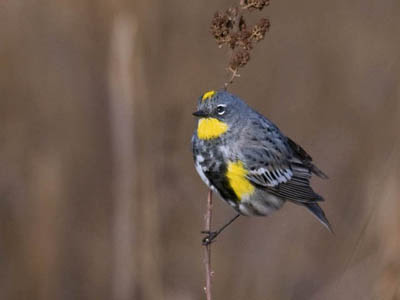 |
| Male Audubon’s Yellow-rumped Warbler. Greg Gillson. |
Western form (Audubon’s) with bright yellow throat and yellow rump. Large white wing patch.
Northern and Eastern form (Myrtle) with white throat, yellow rump, and two white wing bars.
Winter birds are dull gray-brown, with bright yellow rump. Throat may be cream colored or white. Often difficult to tell the two forms apart in winter.
 |
| Winter Yellow-rumped Warbler. Greg Gillson. |
Breed in mountain or boreal conifers. Widespread in migration. Winter in low river bottoms, open weedy deciduous areas. Rarely come to feeders in winter.
Yellow-rumped Warblers are summer residents in central and western Montana, spring and fall migrants only in eastern and northeastern Montana.
Cedar Waxwing
These crested birds with yellow band on the end of the tail are often found in flocks. They eat flying insects in summer, fruit and berries the rest of the year.
 |
| Cedar Waxwing. Greg Gillson. |
These birds are fawn-brown above, with dark gray wings and tail. They have a black mask and wispy crest. The belly is yellow. The wings have waxy red drops on the end of the tertials. The end of the tail has a brilliant yellow tail band.
They are found in open habitats with berries, including juniper woodlands and towns in winter.
Cedar Waxwings are year-round residents throughout Montana.
Evening Grosbeak
These large yellow northern finches are usually found in flocks.
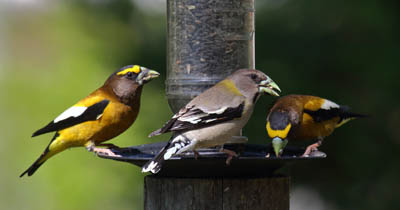 |
| Evening Grosbeaks. Greg Gillson. |
Males are brilliant yellow, with black and white wings. Dusky brown head with bold yellow eyebrow. Huge thick yellow-green bill. White wing patches in flight.
Females are grayer with yellow hind collar, black and white wings. Huge yellow-green bill.
These are birds of northern conifer forests. They often descend to the lowlands in spring to eat seeds of maples, elms.
Evening Grosbeaks are year-round residents in western Montana, winter visitors only in the rest of the state.
Western Tanager
Numbers of these bright black and yellow birds may show up overnight in backyards in spring migration. Then they disappear the next night.
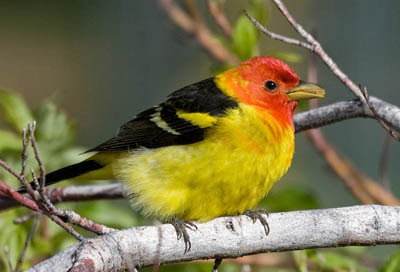 |
| Western Tanager. Greg Gillson. |
Males are brilliant golden yellow with black back, wings, and tail, and a red or orange face. Swollen yellow bill.
Females are more green or gray, with darker wings and tail. Lack red face.
They are found in a variety of wooded habitats, usually conifers or mixed conifer woods, and residential areas with large trees, including mature conifers. Usually don’t visit feeders.
Western Tanagers are summer residents in western, central, and southern Montana, spring and fall migrants through the rest of the state.
Yellow-headed Blackbird
These blackbirds with yellow heads are found in marshes in the West.
 |
| Yellow-headed Blackbird. Greg Gillson. |
Males are glossy black with bright golden-yellow head and breast. White wing patches.
Females are duller brown with mottled yellow breast.
These birds nest in cattail marshes in prairies. Winter in large flocks in agricultural areas.
Yellow-headed Blackbirds are summer residents throughout Montana.
Common Yellowthroat
These buttery yellow birds are abundant in the marsh vegetation.
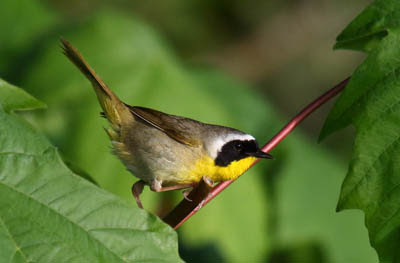 |
| Male Common Yellowthroat. Greg Gillson. |
These skulkers have bright yellow throats and yellow undertail coverts. Males have a black domino mask edged broadly in white, which females lack. Upperparts are dull olive-green.
Immature males in fall show a shadowed black mask.
Found in damp situations and heavy deciduous brambles following clear cuts.
Common Yellowthroats are summer residents throughout Montana.
Western Kingbird
These yellow-bellied birds of the prairies often perch on power lines and fence lines.
 |
| Western Kingbird. Greg Gillson. |
These birds are pale gray on the head and breast. Brown wings. The belly is lemon yellow. Black tail has white outer tail feathers, especially obvious in flight.
These are birds of prairies, deserts, pastures, often near water.
Western Kingbirds are summer residents throughout Montana.
MacGillivray’s Warbler
These are yellow-bellied birds of brushy clear cuts.
 |
| MacGillivray’s Warbler. Greg Gillson. |
These ground-loving birds have gray hoods with white eye arcs. Rest of upper parts green. Breast, belly, under tail bright yellow.
Females have slightly paler gray hood but are otherwise similar to males.
These birds love brushy clear cuts, tangles, thick cover. They stay low.
MacGillivray’s Warblers are summer residents in western and central Montana, absent in eastern Montana.
Wrapping Up
Montana’s diverse landscapes, from snow-capped peaks to rolling grasslands, are home to a captivating variety of colorful birds. But there are also some stunning black and white birds. Here are some of the most fascinating feathered friends you might encounter:
Downy Woodpecker: These small, active birds with black and white streaking are frequent visitors to backyards, parks, and woodlands. Look for them drumming on trees and searching for insects in bark crevices.
Black-billed Magpie: These bold and intelligent birds sport striking black and white plumage with long tails. They are common in open fields, grasslands, and along roadsides, known for their raucous calls and playful antics.
Black-capped Chickadee: These energetic little birds with black caps, bibs, and wingbars flit through trees and undergrowth, searching for insects and seeds. Their distinctive “chick-a-dee-dee-dee” call is a frequent soundtrack to Montana woodlands.
Snow Bunting: During winter months, these social birds with black and white plumage, including a distinctive black and white head pattern, flock to open fields and snowy landscapes. Watch for their acrobatic flight displays and energetic group movements.
Frequently Asked Questions
What kind of bird has a red throat in Montana?
Most likely you are looking at the Red-naped Sapsucker. Males have a bright red throat patch extending up the neck, while females have a white throat with a red patch below. They frequent coniferous forests.
What are the yellow and red birds in Montana?
The Western Tanager is a vibrant splash of color in Montana’s forests and woodlands, but finding them requires knowing where to look and when to go. Here are some tips to increase your chances of spotting these fiery feathers:
Habitat:
- Open coniferous forests: Look for stands of lodgepole pine, Douglas fir, ponderosa pine, and mixed conifer forests, especially at higher elevations (usually above 4,000 feet).
- Riparian areas and stream edges: Look for tall trees and dense foliage along rivers and streams.
- Forest edges and clearings: Tanagers might sometimes venture into openings within forested areas.
Season:
- Spring and early summer (May-July): This is the prime time for seeing Western Tanagers in Montana during their breeding season. Males are at their most colorful with their blazing red body and black head.
- Fall migration (September-October): Smaller numbers of migrating Tanagers might be seen on occasion, but they are less active and visible compared to breeding season.
Specific Locations:
- Glacier National Park: Head to dense coniferous forests along roads and trails, particularly around McDonald Creek and Logan Pass.
- Yellowstone National Park: Explore conifer forests around Lower and Upper Falls, Canyon, and Mammoth Hot Springs.
- Flathead National Forest: Look for Tanagers in the Swan Mountains and Whitefish Range, especially along streams and forest edges.
- Lewis and Clark National Forest: Dense forests around Lincoln and Helena offer promising habitats, particularly along the Continental Divide.
Is a yellow warbler a finch?
No, a Yellow Warbler is not a finch. They belong to different bird families with distinct characteristics:
Here’s a quick table summarizing the key differences:
| Feature | Yellow Warbler | Finch |
|---|---|---|
| Family | Parulidae | Fringillidae |
| Size | Small (5 inches) | Varies (small to medium) |
| Bill | Thin and pointed | Short and conical |
| Legs | Long and slender | Short and sturdy |
| Song | Complex and varied | Simple and repetitive |
| Habitat | Open woodlands, fields, shrublands | Diverse (fields, grasslands, forests, urban areas) |
| Diet | Insects | Seeds |
Related Articles:
See photos and learn about the most common backyard birds in Montana, regardless of color.
Here’s a quick tutorial of how I would teach you to identify birds: 7 Steps to Identify Birds!
Birds with red heads in North America.
Yellow-and-black birds in North America.










